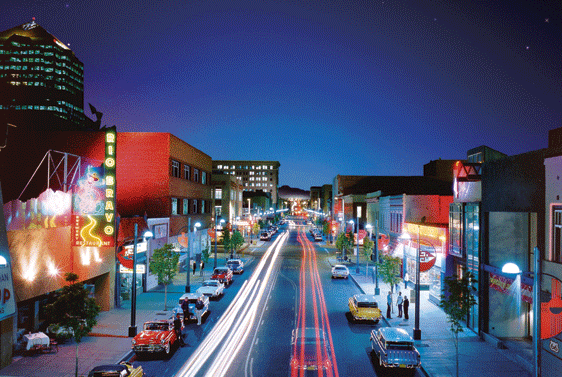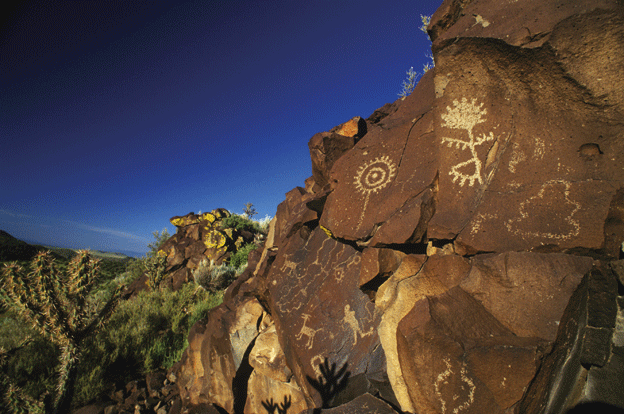
Travel
New Mexico
A Classic and
Quirky Road Trip

What my wife and I had in mind on our most recent road trip, was checking out some of the area’s quirkier attractions. There certainly are plenty of possibilities.
By: Tom Passavant *
“If I buy a house in Santa Fe, I could start my new life here,” said a woman in a long blue-jean skirt and thick sweater. She was navigating the aisles of a furniture consignment shop on the south side of town when I overheard her. I could easily imagine the British novelist D.H. Lawrence or the American artist Georgia O’Keeffe -- two of the more illustrious people who came to love the area -- saying much the same thing when they first encountered northern New Mexico nearly a century ago. The views! The light! The unspoiled towns!
The good news is that so much of what appealed to O’Keeffe and company is still remarkably intact. All sorts of dreamers, artists and visionaries continue to flock to the area, and that is a large part of its timeless appeal. Add in enough 21st-century wealth to support innumerable art galleries, a first-class music scene and a singular cuisine, and you’ve got a place that truly gets under your skin, so much so that the longing is satisfied only by another round of green chile cheeseburgers, another evening at the open-air Santa Fe Opera, another pumpkin-colored sunset igniting the desert and mountains.
What my wife and I had in mind on our most recent road trip, though, was checking out some of the area’s quirkier attractions. There certainly are plenty of possibilities. In just over a week, making a clockwise drive around northern New Mexico, we managed to stay at a homesteader’s cabin in the middle of a lightning field and at a perfectly preserved 1930s motel on Route 66. We visited one of the world’s largest arrays of radio telescopes, a nuclear museum and even had a slice of pie in Pie Town.
The Tao Of Taos
After driving from our home in Colorado, we started our tour in Taos. (Most visitors begin by flying into Albuquerque, an hour south of Santa Fe, but our loop is easy to jump on and off at any point.)
The Taos economy is almost entirely based on tourism. That’s not too surprising, given attractions like the Taos Pueblo (if you’ve got time for only a single pueblo visit, this is the one), the Millicent Rogers Museum (home to truly breathtaking Indian artifacts), the Harwood Museum of Art (with a fine collection of Taos Society and modernist paintings) and in winter, some of North America’s best skiing. Then there’s that astonishing astringent light, so pure it’s like you just put your eyeballs through a car wash. Even bad art can look good in this light.
Albuquerque: Authentic And Otherwise
After Taos, we drove to Santa Fe and took a scenic route called the Turquoise Trail south to Albuquerque. Albuquerque is far more attractive than it looks if you just whiz by it on the interstate. The northwest corner of town, for example, is lush with cottonwoods, sprawling horse farms and vineyards. We enjoyed a few hours at the National Atomic Museum, on the edge of Old Town. The exhibits take an evenhanded look at nuclear history and include everything from wartime propaganda to irradiated food. The gift shop features bumper stickers that read, “get a half-life.”
The best part of our stay in Albuquerque was spending the night at Casas de Suenos. About three blocks from Old Town, the central house was built by the artist J.R. Willis in 1930. He added casitas around charming inner courtyards to house all the friends who kept dropping by to visit. Today Casas de Suenos evokes a kinder, gentler era of travel with antiques, comfortable beds and full kitchens.
Off The Beaten Path
From Albuquerque, we headed south for an hour on I-25 to Socorro, then drove west into lovely mountains that were dotted with junipers and pinons. In Pie Town, the Pie-Oh-Neer restaurant was closed, so we had to be content with coffee and slices of pecan and double chocolate from the Daily Pie Cafe. Then we came upon the Very Large Array, one of the world’s biggest collections of radio telescopes, which look like white mushrooms lined up across miles of open sagebrush desert.
Space was also the theme of our overnight stay at The Lightning Field. Visitation is limited to six people who stay overnight at a ramshackle but comfortable 1930s-era homesteader’s cabin. The renowned piece of environmental art, designed by the American sculptor Walter De Maria in 1977 and set on pristine terrain outside Quemado, consists of 400 stainless-steel poles, each about 20 feet tall, planted over a one-mile-by-one-kilometer grid. Though the location is peppered by storms, The Lightning Field is really about the play of sunlight on a landscape utterly devoid of life, save the pronghorns and jackrabbits that scamper across the fields. The silence was deafening, and at night, not a single man-made light could be seen for 50 miles in all directions.
On The Road To Gallup
If you want to get a feel for cross-country travel in the heyday of the famous American highway known as Route 66, head for Gallup. Once there, you’ll find that the trains still whistle and rumble through day and night, and several original motor courts recall the innocence of road travel after World War II.
We spent a long time admiring the merchandise at Richardson’s Trading Company, one of the original pawnshops where Indians have long come to exchange jewelry, blankets and other items for cash. El Rancho Hotel and Motel, built in 1937 by the brother of film director D.W. Griffith, is where movie stars from Errol Flynn to Kirk Douglas stayed while filming westerns out in the desert. We spent a fairly comfortable night there. Take a stroll around the lobby, which could easily double as a museum of western and Hollywood memorabilia.
 Savoring Santa Fe
Savoring Santa Fe
We had saved Santa Fe for last because we wanted plenty of time. First, we washed off the road dust at the beautifully revived Galisteo Inn, 17 miles south of town. Surrounded by low adobe walls and shaded by enormous cottonwoods, the inn is an old hacienda with a big heated swimming pool (a rarity in parched New Mexico) and its own La Mancha Restaurant.
By now we were ready to start wandering on foot. There are more than 250 art galleries in town, the majority within strolling distance of the 400-year-old plaza. On the north side of the plaza, under the covered walkway of the Palace of the Governors, jewelry-makers from various Indian tribes still sit every day selling their excellent hand-fashioned work. Two of our favorite finds this trip were the Shiprock Santa Fe gallery, upstairs on the plaza, and Double Take, a mile or so away in the booming Guadalupe District. The former offers not only the finest quality Navajo textiles we’ve ever seen, but wood furniture by the American master George Nakashima. At Double Take, the aisles are filled with everything from consignment clothing to cowboy memorabilia. If you want a pair of broken-in boots in wild colors, this is the place.
The Guadalupe District abuts the Railyard, the biggest thing to hit Santa Fe in decades. Fifty acres of formerly decrepit tracks and fields are in the process of becoming a neighborhood. Centered on SITE Santa Fe, a pioneering gallery in large-scale installation art, the Railyard will, by this summer, include a park, a permanent home for the renowned Santa Fe Farmer’s Market, and other galleries featuring contemporary art.
If Santa Fe sometimes wears its quirkiness on its sleeve, it doesn’t ever become grating. There may be too many balding guys with little gray ponytails, and chunky turquoise necklaces don’t really work as everyday dress for women. But we still love those farolitos, the light-filled paper bags that outline rooftops all over town, and the scent of wood smoke that fills the air at sundown is always intoxicating.
Three Routes To Explore
Northern New Mexico has several well-known half-day-or-so drives. The famous High Road that links Taos to Santa Fe is a 54-mile stretch that passes by Scenic small towns where you’ll find many weavers, potters and silversmiths. The Turquoise Trail National Scenic Byway heads south from Santa Fe and, a couple of hours later, pops out just east of Albuquerque. The lack of development in this region surprises visitors, as does the fact that the terrain is not dusty desert, but often forests of bushy, dark green trees. The highlight is a bend in the road called Madrid, a town where artists have turned dilapidated storefronts and homes into galleries.
New Mexican Hideaways
• Casas de Suenos Albuquerque. 800-665-7002; casasdesuenos.com. Rooms from $129.
• El Monte Sagrado Taos. 800-828-8267; elmontesagrado.com. Rooms from $309.
• El Rancho Hotel and Motel Gallup. 800-543-6351; elranchohotel.com. Rooms from $68.
• El Rey Inn Santa Fe. 800-521-1349; elreyinnsantafe.com. Rooms from $99.
• The Galisteo Inn Galisteo. 866-404-8200; galisteoinn.com. Rooms from $135.
• The Inn of the Five Graces Santa Fe. 505-992-0957; fivegraces.com. Rooms from $300.
• The Lightning Field Outside Quemado. 505-898-3335; lightningfield.org. $150 per person, including dinner and breakfast. Open May through October.
* Tom Passavant, an editor at Diversion magazine, has traveled widely in the American West.